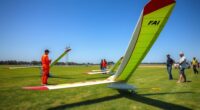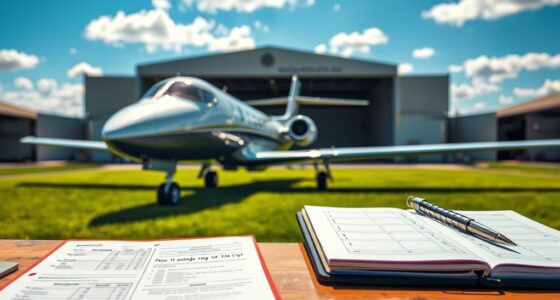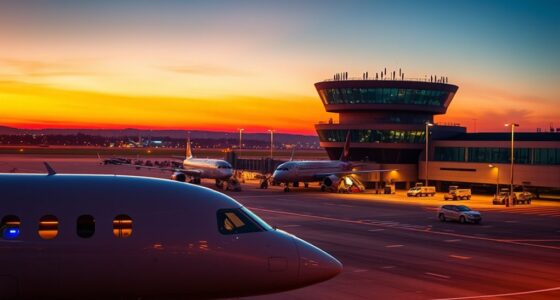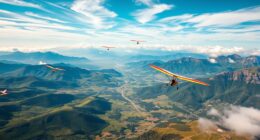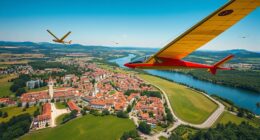In controlled airspace, radar identification and continuous ATC communication help you maintain safe separation from commercial traffic, guiding your movements precisely. In uncontrolled areas, you rely on visual cues, self-position reporting, and keeping a vigilant lookout to stay clear. Understanding how radar and communication work in each environment is key to safety. The more you learn about these distinctions, the better you’ll be at keeping safe distances—discover more as you explore these concepts further.
Key Takeaways
- In controlled airspace, radar and ATC instructions help maintain safe distances from commercial traffic.
- Uncontrolled airspace relies on pilot vigilance, visual cues, and radio communication to keep safe separation.
- ATC radar identification enhances aircraft tracking and safety near commercial routes in controlled zones.
- Pilots in uncontrolled areas must proactively report positions and communicate intentions to avoid conflicts.
- Adapting flying practices to environment—using radar and ATC in controlled zones versus self-awareness in uncontrolled—ensures safety.

Understanding the differences between controlled and uncontrolled airspace is essential for pilots and aviation enthusiasts alike. When flying through these regions, you need to be aware of how aircraft are identified and how you communicate with others to maintain safety and avoid conflicts. In controlled airspace, radar identification plays a crucial role. Air traffic control (ATC) uses radar systems to track every aircraft within these zones, allowing them to identify and monitor your position precisely. This radar identification helps ATC provide you with clear instructions, ensuring you stay separated from other traffic, especially around busy airports. When you enter controlled airspace, you’re expected to establish and maintain communication with ATC. This means listening to radio calls, responding promptly, and following their instructions carefully. Clear pilot communication is vital here; it helps prevent misunderstandings that could lead to near misses or accidents. You should always identify yourself when contacting ATC and report your position, altitude, and intentions clearly. This ongoing exchange keeps everyone informed and enhances safety in congested areas. Additionally, modern technology such as transponder systems further improves aircraft detection and tracking within controlled zones, increasing overall safety.
In contrast, uncontrolled airspace operates with minimal or no direct oversight from ATC. Here, radar identification isn’t typically available, and pilots rely more heavily on visual cues and self-separation. Since ATC doesn’t monitor your flight, your ability to see and be seen becomes your primary safety tool. When flying in uncontrolled regions, you’re responsible for maintaining a safe distance from other traffic, especially commercial aircraft that often operate at higher speeds and altitudes. It’s essential to be vigilant, make early position reports when necessary, and use your radio to communicate your intentions to nearby pilots. Although you won’t receive the same level of guidance as in controlled airspace, good pilot communication remains essential. Announcing your position and intentions helps others anticipate your movements, reducing the risk of collision. Using common traffic advisories and listening to broadcasts on common traffic frequencies allows you to stay aware of nearby aircraft and react accordingly.
Whether you’re navigating controlled or uncontrolled airspace, understanding how radar identification and pilot communication work together is key to keeping safe distances from commercial traffic. In controlled zones, ATC’s radar and directives provide a safety net, but in uncontrolled airspace, your vigilance and effective communication become your best tools. Always adapt your flying habits to the environment and respect the rules, so you can enjoy your flight while maintaining the highest safety standards.
Frequently Asked Questions
How Do Pilots Communicate in Uncontrolled Airspace?
In uncontrolled airspace, you communicate with other pilots using radio procedures, such as making position reports and listening for traffic advisories. You also use visual signals like light signals or aircraft position indicators to alert others. Always stay alert, keep your radio tuned to common frequencies, and use clear, concise language to guarantee safe separation from commercial traffic. Visual cues and radio communication are key for safe navigation.
What Equipment Is Necessary for Flying in Uncontrolled Zones?
When flying in uncontrolled zones, you need essential equipment like a VFR chart for visual navigation and a reliable radio for communication. Carry a GPS device to assist with navigation, and have emergency landing procedures clearly mapped out. Always keep a visual lookout for other aircraft, especially commercial traffic, and be prepared to communicate your intentions. This gear helps guarantee safety and smooth navigation in areas without controlled airspace.
Are There Specific Rules for Recreational Drone Flights?
Think of recreational drone laws as a map guiding your flight through friendly skies. You need drone flight permissions, stay below 400 feet, and avoid flying near airports or crowds. Always keep your drone within line of sight and respect privacy. By following these rules, you guarantee your aerial adventures stay safe and legal, like a bird steering open skies without disturbing the flock.
How Is Airspace Classified in Urban Areas?
In urban areas, airspace classification relies on urban airspace management and zoning regulations to guarantee safety. You need to follow local rules governing drone flights, which often include designated zones for recreational or commercial use. Pay attention to restrictions near airports, busy streets, or crowded areas. Staying within permitted zones and adhering to altitude limits helps you fly responsibly, avoiding conflicts with manned aircraft and ensuring safety for everyone.
What Are the Penalties for Violating Airspace Regulations?
Think of airspace violations like speeding through a busy intersection—risks are high. If you violate airspace regulations, you face regulatory penalties such as hefty fines, license suspension, or even jail time. For example, authorities once fined a drone operator $20,000 for unauthorized flights near airports. These penalties aim to keep everyone safe. Ignoring airspace rules puts you at serious legal and safety risks—don’t cut corners, stay compliant.
Conclusion
So, next time you’re flying solo in uncontrolled airspace, remember it’s like wandering through a quiet neighborhood—peaceful until a commercial jet suddenly appears. Ironically, the chaos of controlled airspace keeps everyone safe, but it’s the unassuming pilots in uncontrolled zones who must stay alert. Keeping your distance isn’t just good sense; it’s your best chance to avoid a high-altitude collision. After all, in aviation, the quietest skies often hide the biggest surprises.
With a heart that soars as high as the skies, Aria, affectionately known as “Skylark,” is the driving force behind Soaring Skyways. Her journey into the gliding world began as a young dreamer gazing up at the soaring birds, yearning to experience the weightlessness and freedom they embodied. With years of experience both in the cockpit and behind the scenes, Aria’s commitment to the gliding community is unwavering.

